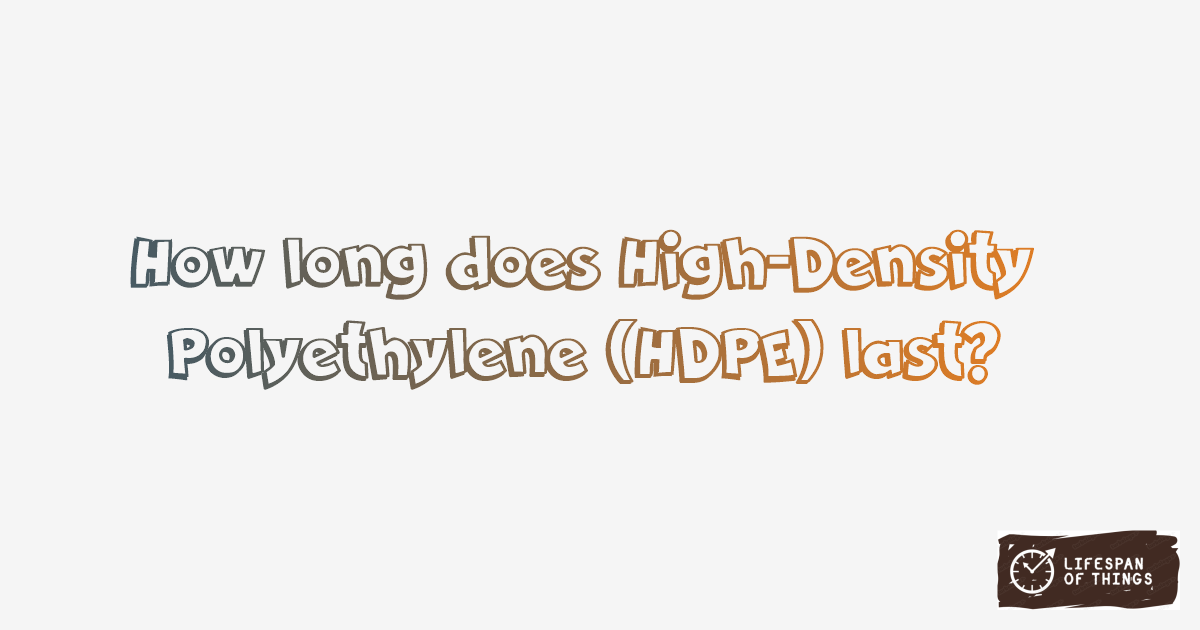
50 - 100 Years
Lifespan of High-Density Polyethylene (HDPE) is 50 - 100 Years. High-Density Polyethylene (HDPE) durability and longevity are influenced by factors like exposure to sunlight, temperature variations, and chemical resistance. Proper storage and handling can extend its lifespan significantly.
Useful Information
High-Density Polyethylene (HDPE) is known for its strength, flexibility, and resistance to chemicals. It is available in various types, including HDPE grades with additives for specific applications.
High-Density Polyethylene (HDPE) finds uses in industries like packaging, construction, and healthcare due to its versatility. Its applications range from water pipes and containers to medical devices and toys.
Explore how commodity plastics play a crucial role in packaging solutions due to their versatility and durability. Read more
High-Density Polyethylene (HDPE) exhibits durability under different conditions, such as temperature and chemical exposure. Factors affecting its lifespan include UV exposure, stress cracks, and proper maintenance practices.
The environmental impact of High-Density Polyethylene (HDPE) production includes energy consumption and waste generation. However, recycling and using recycled HDPE can reduce its environmental footprint. Sustainable practices like reducing plastic waste further mitigate its impact.
To care for High-Density Polyethylene (HDPE), avoid exposing it to prolonged sunlight and harsh chemicals. Regular cleaning with mild soap and water helps maintain its appearance. Storing HDPE items away from extreme temperatures and mechanical stress can prolong their lifespan.
Lifespan Comparisons
| Compared Item | Comparison Description |
|---|---|
| Lifespan of Low-Density Polyethylene (LDPE) | High-Density Polyethylene (HDPE) lasts significantly longer than Low-Density Polyethylene (LDPE) by 40-85 years. |
| Lifespan of Expanded Polystyrene (EPS) | Expanded Polystyrene (EPS) has a potential lifespan extending up to 1000 years, surpassing High-Density Polyethylene (HDPE) by a wide margin. |
| Lifespan of Polypropylene Copolymers | Polypropylene Copolymers have a slightly shorter lifespan compared to High-Density Polyethylene (HDPE) due to differences in composition. |
| Lifespan of Thermoplastic Elastomers (TPE) | Thermoplastic Elastomers (TPE) are durable but not as long-lasting as High-Density Polyethylene (HDPE), lasting about 15-20 years. |
| Lifespan of Ceramic Composites | Ceramic Composites offer a lifespan varying between 10-20 years, similar to High-Density Polyethylene (HDPE) in longevity. |
| Lifespan of Carbon Fiber Sheets | Carbon Fiber Sheets have a shorter lifespan than High-Density Polyethylene (HDPE) due to different materials, lasting around 5-10 years. |
| Lifespan of Carbon Fiber Tubes | Carbon Fiber Tubes vary in lifespan from 5-15 years, generally falling below the longevity of High-Density Polyethylene (HDPE). |
| Lifespan of Carbon Fiber Panels | Carbon Fiber Panels deliver a lifespan exceeding 15 years, potentially outlasting High-Density Polyethylene (HDPE) in durability. |
| Lifespan of White Wine | White Wine has a considerably shorter lifespan than High-Density Polyethylene (HDPE), typically lasting only 3-5 years. |
| Lifespan of Beer | Beer has a moderate lifespan of 2-5 years, shorter compared to the extended longevity of High-Density Polyethylene (HDPE). |
| Lifespan of Whiskey | Whiskey provides a lifespan of 5-10 years, aligning closely with the long-term durability of High-Density Polyethylene (HDPE). |
| Lifespan of Vodka | Vodka's lifespan ranges from 5-10 years, akin to High-Density Polyethylene (HDPE) in longevity and reliability. |
| Lifespan of Orange Juice | Orange Juice has a short shelf life of 7-10 days, significantly less than the robust longevity of High-Density Polyethylene (HDPE). |
| Lifespan of Apple Juice | Apple Juice typically lasts 7-10 days, falling short of the enduring quality seen in High-Density Polyethylene (HDPE). |
| Lifespan of Grape Juice | Grape Juice offers a lifespan of 2-5 years, differing from the extended durability provided by High-Density Polyethylene (HDPE). |
Frequently Asked Questions
Lifespan of High-Density Polyethylene (HDPE) is 50 - 100 Years.
High-Density Polyethylene (HDPE) is favored in packaging due to its strength, flexibility, and chemical resistance.
Extended exposure to sunlight can degrade High-Density Polyethylene (HDPE), reducing its lifespan.
Yes, recycling High-Density Polyethylene (HDPE) can significantly reduce its environmental footprint.
Regular cleaning with mild soap, avoiding extreme temperatures, and proper storage can help extend the lifespan of HDPE products.








